The different context that (hugging) is being performed in (digital spaces, physical, together with others).
Hugging demonstrates affection and emotional warmth, sometimes arsing from joy or happiness when reunited with someone or seeing someone absent after a long time.
America remains a “medium” touch culture—more physically demonstrative than Japan, where a bow is the all-purpose hello and goodbye, but less demonstrative than Latin or Eastern European cultures, where hugs are robust and can include a kiss on both cheeks.
Source:
https://www.wsj.com/articles/SB10001424127887324549004579064981148637884
There are also different types of hugs such as:
1. Group hug
2. Bear hug
3. Polite hug
4. Intimate hug
5. Back hug
And more!
A digital hug is mostly being used on the internet. An example of an digital image showing a hug:
Not only humans make the hug gesture but also animals.
Some animals "hug" or embrace, but by and large most do not, so for most animals hugging isn't a natural sign of affection; the closest thing most animals get to "hugging" is mounting behavior, which can often be seen in both males and females as either part of the breeding process or as an assertion of dominance.
Affection then regulates the pull of competition and cooperation. It acts as a device that allows the coexistence of opposite impulses. As this principle of pleasure is already established in some species, it could could activate upon physical contact. "When we pet for example an iguana, we are actually taking advantage of a communication channel that already exists between inguana’s.”
Source: https://worldcrunch.com/culture-society/what-science-says-about-animals-that-love-human-cuddles
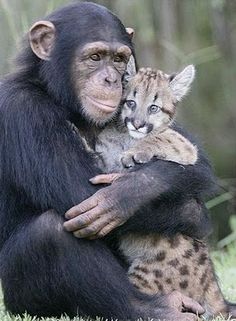
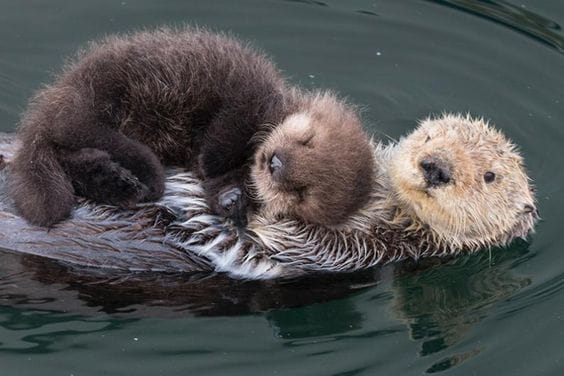

The widespread adoption of hugging over the recent years has been debated to be due to two primary reasons: the reduced formality of dress code and manners between relationships, along with the changing behaviours of political figures in pursuit of a more relatable, warm-hearted perception to the public.
Source: http://kulraj.org/2014/09/09/science-of-hugs/
No one knows exactly when the first hug occurred between two human beings, but we do know that hugs have been in the human behavioral repertoire for at least several thousand years. In 2007, a team of archeologist discovered the so-called “Lovers of Valdaro” in a Neolithic Tomb near Mantua in Italy (Stewart, 2007). The lovers are a pair of human skeletons that have been buried holding each other in a tight embrace. They have been determined to be approximately 6000 years old, so we know for sure that people already hugged each other in Neolithic times.
Source: https://www.psychologytoday.com/us/blog/the-asymmetric-brain/201901/national-hugging-day-five-scientific-facts-about-hugging
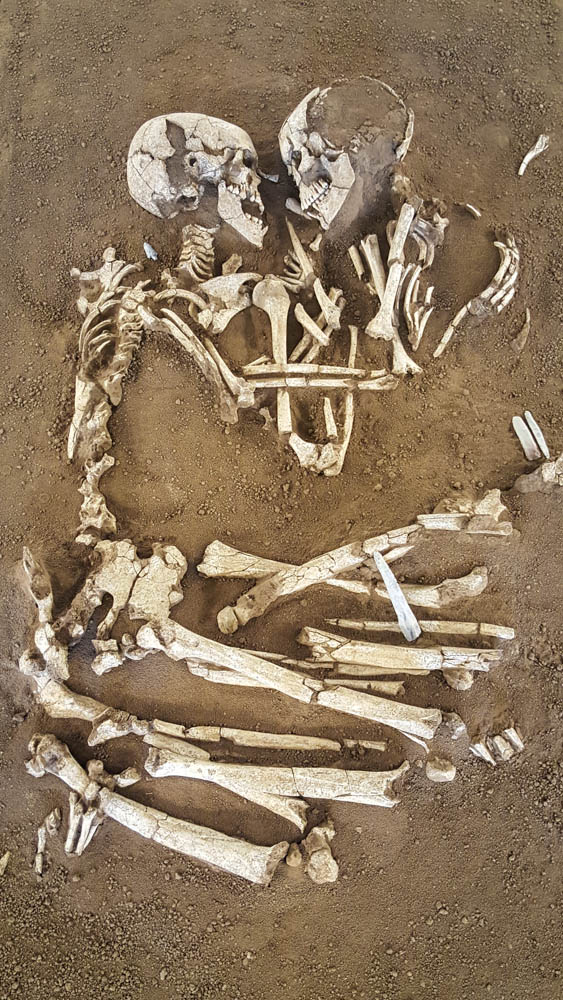
The bodies that perform hugging:
The evolution of hugging:
In which other contexts does this gesture appear?
Therapy
In the so-called holding therapy, the participants hold each other in their arms and look into each other's eyes until painful feelings, aggressive impulses or fears first appear in this very unusual confrontation. These are held in the embrace until they dissolve and it becomes a loving embrace.
Source: https://www.berliner-zeitung.de/festhaltetherapien-sollen-gestoerten-kindern-helfen-aber-womoeglich-haben-sie-ueble-folgen-im-griff-der-eltern-li.11092
Corona Pandemic
An intentional pleasant hug can give us the feeling of trust, affection, security and comfort and is essential for humans. Due to the Corona Pandemic, hugging has become something to avoid as it spreads the virus. Many of us realized how important these touches are for us only since this abandonment.
Source: https://www.dw.com/de/trotz-corona-ist-kuscheln-gesund-ich-werde-umarmt-also-bin-ich/a-55811803
How did the gesture travel from one body to another one?
One of the first human experiences in the life of a newborn is the hug. After birth, it lies in the arms of its mother, who nurses it at her breast. Also during growth, it receives many hugs, which become symbols of something positive: Joy, security and self-confidence. So from the very beginning, we learn the importance of hugs and then relatively quickly apply this to people (especially parents), animals and cuddly toys.
From the beginning, it was important for humans not to show hostility to people they met for the first time. This is possible with the hug as a greeting pattern. There is written evidence of this in the Bible or in religious texts of the Orient.
Source: https://journals.sagepub.com/doi/full/10.2466/02.17.21.CP.1.13
How does the gesture have different meanings depending on the body that perform?
The way of hugging depends on several factors. There are gender and cultural differences in hugging. A study from 1973 shows (in which, however, only women and men were represented) that at that time among women hugging was more frequent. For men, it was more often the handshake. It has been suggested that the reason for this is the need for men to show control and dominance.
The cultural differences were observed in a study in 1977. In all Western cultures, the hug is often followed by a kiss on the cheek. In Northern Europe, handshaking is more common, while in Southern Europe, hugging is more common. A person who grows up in an environment where hugging is a common greeting tends to adopt this greeting behaviour.
Source: https://journals.sagepub.com/doi/full/10.2466/02.17.21.CP.1.13
Where & when does this gesture appear?
Hugging appears in lots of situations, especially informal ones.
At birthdays
At school
When you see someone you know
When saying good bye
In clubs
At home
Between friends
Between lovers
Between family
In a first, informal meeting
What is the history of this gesture? Did it evolve through time?
Verb first used in the 1590s
A pair of skeletons have been found from over 6000 years ago, they were hugging. From this we know for sure people hugged from at least that time.
source: http://kulraj.org/2014/09/09/science-of-hugs/
What is the cultural meaning of this gesture? Did it evolve through time?
Only over the past 50 years, hugging in public has become widely accepted, being seperated from more intimate things like kissing.
The gesture itself has not changed significantly over time, though the meaning and acceptance of the activity have changed drastically.
Hugging each other is now a very normal and accepted thing to do. Because the world became more and more informal and hugging became less associated with sex, it was normalised.
Nowadays, whe have to think twice when hugging someone. First of all we have to think about if it is okay to hug the person in question. They have to also feel comfortable with the hug. Over the past years luckily people became more aware of how important it is to have mutual consent.
And then of course we are now dealing with the corona virus, which makes you think like 10 times before you hug anyone.
The question is whether that will ever return to 'normal'?
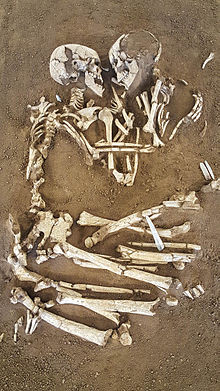




ALTERNATIVE GESTURE
PROBLEM: Hugging can be too intimate for some people => develop a gesture that is less intimate
with corona, it is also not good to hug => finding a gesture where you are not touching the other person
- something like waving
- air hug
- corona hug
OUR GOAL => FIND A WAY TO ALSO DECLINE A HUG IF SOMEBODY IS NOT COMFORTABLE WITH IT
create a sign to signalize the other person that you are not feeling comfortable with hugging/ that you want to do the air hug
OUR ALTERNATIVES
- HAND HUG (less touchy, same feeling)
important because some people like to touch, but not
necessarily with their whole bodies, so a hand hug could be the solution
- AIR HUG (no touch, very corona safe, not so intimate)
very handy and convenient with corona, less of
the feeling of intimacy
- HUGGING WAVE (new kind of waving, more intimate meaning)
more meaning than a regular wave, no problem of unwanted touch
WE WANT TO SPARK A CONVERSATION AND QUESTION THE SOCIAL NORM
DIFFERENT WAYS OF HUGGING
ALTERNATIVE SET OF GESTURE
MAKING THE GESTURE VIRAL
- Some people don't like to hug because it can be too intimate for them, also because of corona you should avoid hugging.
- There are 3 alternatives you can choose, which could work well instead of hugging. The air hug and the hugging wave are less intimate and you can keep enough distance. However, the hand hug is maybe for some people more intimate than the normal hug but you don't have to involve your whole body.
- The air hug and the hugging wave are much more corona proof and you still say different hallo than just waving your hand.
- The new way of hugging is more choreography and you can also do the first 2 new ways of hugging in a group.
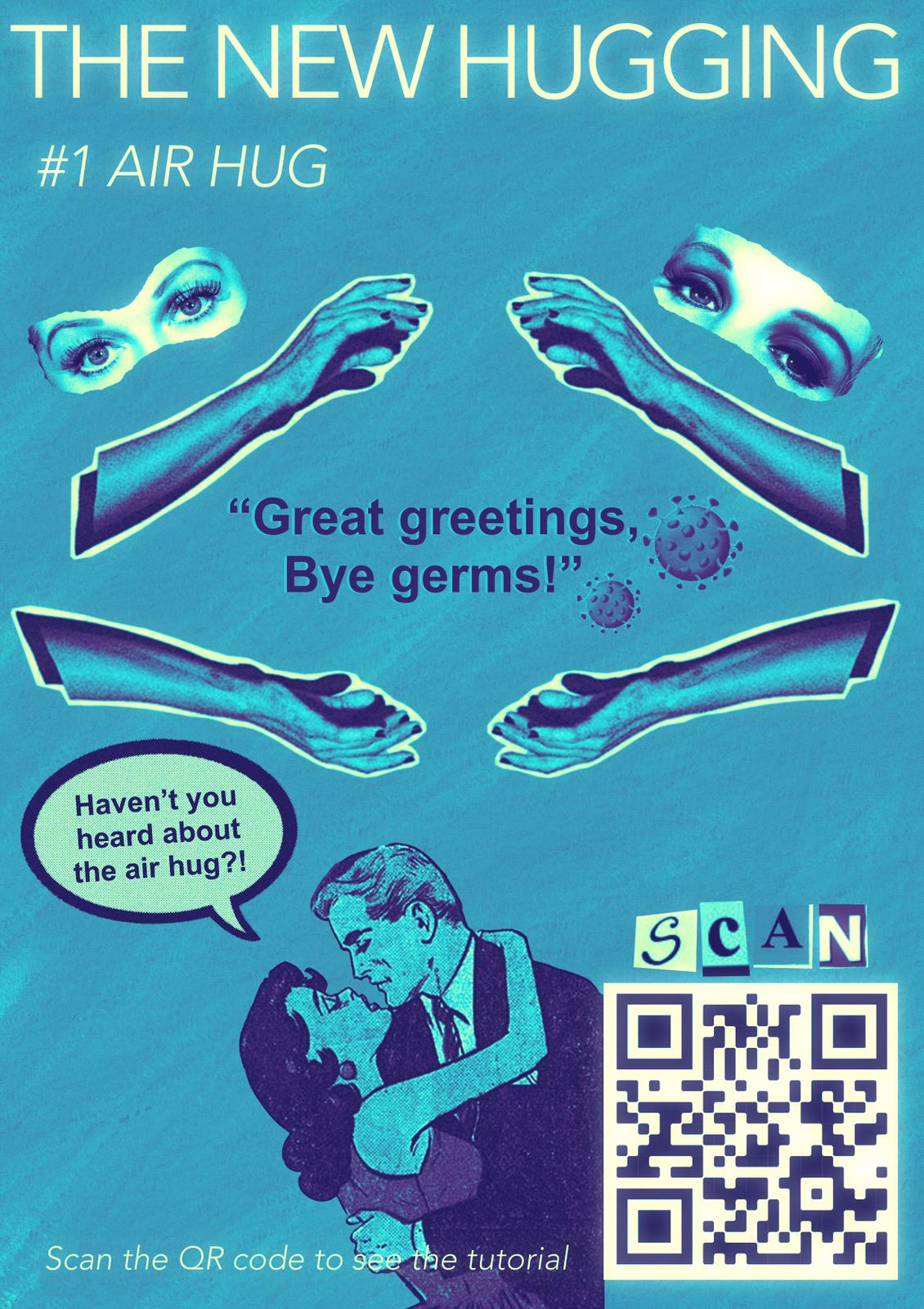
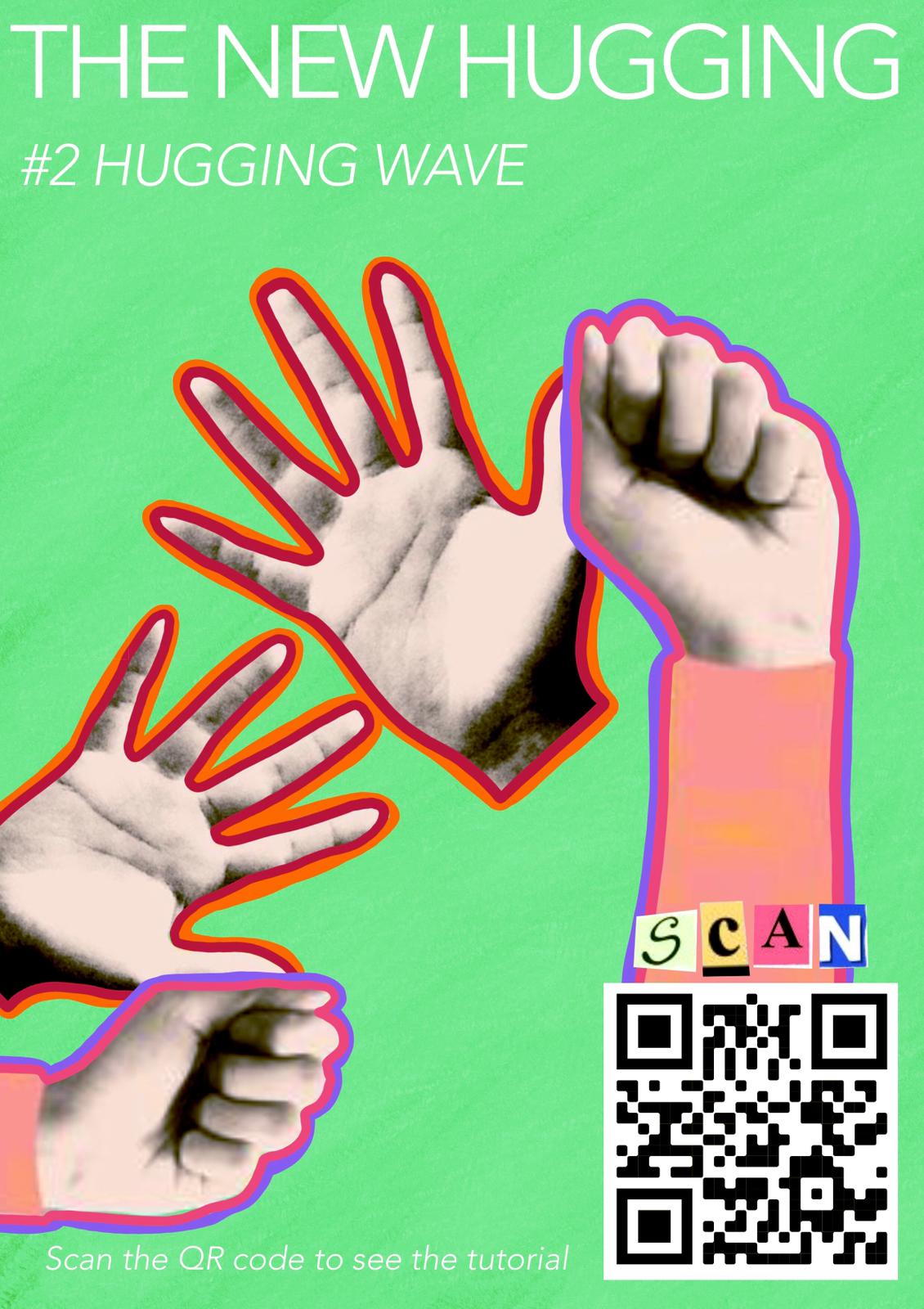
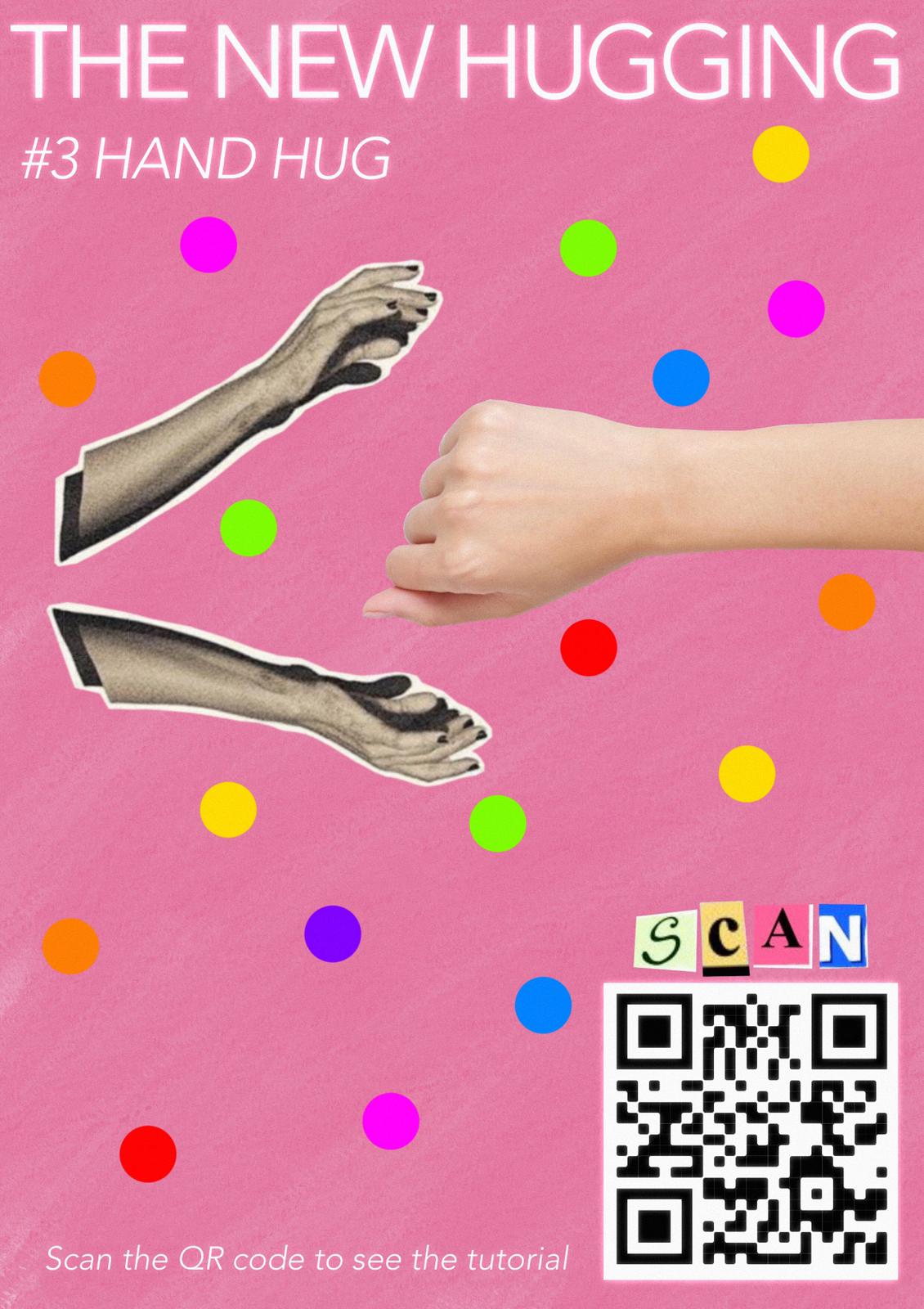
Our audience is students. Since the corona pandemic is still going on it is good to have an alternative saying hello to your friends in the WDKA. With a visually nice poster design, we want to reach the students. Via a QR code, you can see on a video how the new ways of hugging work. We put the posters on the location where students easily can recognize them and pass by.